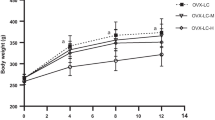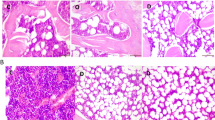Abstract
It has been reported that Astragalus membranaceus, an Asian traditional herb, has an estrogenic effect in vitro. To examine the possible role of A. membranaceus extract with supplemental calcium (Ca) on bone status in calcium-deficient (LCa) ovariectomized (OVX) rats, a total of 48 female rats were divided into six groups: (1) normal control, (2) sham operation with LCa (sham-LCa), (3) OVX with LCa (OVX-LCa), (4) A. membranaceus supplementation with OVX-LCa (OVX-MLCa), (5) Ca supplementation with OVX (OVX-Ca), and (6) A. membranaceus and Ca supplementation with OVX (OVX-MCa). A. membranaceus ethanol extract (500 mg/kg BW) and/or Ca (800 mg/kg BW) were administered orally for 8 weeks along with a Ca-deficient diet. Results revealed that Ca supplementation with or without A. membranaceus extract significantly improved bone mineral density, biomechanical strength, and ash weight of the femur and tibia in OVX rats. High Ca with A. membranaceus combination supplementation significantly increased the ash weight of the femur and tibia and decreased urinary Ca excretion compared with supplementation of Ca alone. Uterine weight was not changed by A. membranaceus administration in OVX rats. These results suggest that A. membranaceus extract combined with supplemental Ca may be more protective against the Ca loss of bone than A. membranaceus or supplementation of Ca alone in calcium-insufficient postmenopausal women.
Similar content being viewed by others
References
Lewiecki EM (2008) Prevention and treatment of postmenopausal osteoporosis. Obstet Gynecol Clin North Am 35:301–315
Flynn A (2003) The role of dietary calcium in bone health. Proc Nutr Soc 62:851–858
The Korean Nutrition Society (2010) Dietary reference intakes for Koreans 2010. The Korean Nutrition Society, Seoul, p 9
Institute of Medicine, Standing Committee on the Scientific Evaluation of Dietary Reference Intakes, Food and Nutrition Board (1997) Dietary reference intakes for calcium, phosphorous, magnesium, vitamin D, and fluoride. National Academy Press, Washington, DC, p p25
Ministry of Health, Welfare and Family Affairs & Korea Center for Disease Control and Prevention (2010) 2011 National Health Statistics—The 5th Korea National Health and Nutrition Examination Survey, the first year (2010). Korea Center for Disease Control and Prevention, Seoul, p 359–372
Burnett-Hartman AN, Fitzpatrick AL, Gao K, Jackson SA, Schreiner PJ (2009) Supplement use contributes to meeting recommended dietary intakes for calcium, magnesium, and vitamin C in four ethnicities of middle-aged and older Americans: the Multi-Ethnic Study of Atherosclerosis. J Am Diet Assoc 109:422–429
American Association of Clinical Endocrinologists (2003) Medical guidelines for clinical practice for the prevention and treatment of postmenopausal osteoporosis. Endocr Pract 9:545–564
National Osteoporosis Foundation (2010) Clinician's guide to prevention and treatment of osteoporosis. National Osteoporosis Foundation
Breitman PL, Fonseca D, Cheung AM, Ward WE (2003) Isoflavones with supplemental calcium provide greater protection against the loss of bone mass and strength after ovariectomy compared to isoflavones alone. Bone 33:597–605
Nieves JW, Komar L, Cosman F, Lindsay R (1998) Calcium potentiates the effect of estrogen and calcitonin on bone mass: review and analysis. Am J Clin Nutr 167:18–24
Writing Group for the Women's Health Initiative Investigators (2002) Risks and benefits of estrogen plus progestin in healthy postmenopausal women: principal results from the Women's Health Initiative randomized controlled trial. JAMA 288:321–333
Miksicek RJ (1994) Interaction of naturally occurring nonsteroidal estrogens with expressed recombinant human estrogen receptor. J Steroid Biochem Mol Biol 49:153–160
Hirotani M, Zhou Y, Rui H, Furuya T (1994) Cycloartane triterpene glycosides from the hairy root cultures of Astragalus membranaceus. Phytochemistry 37:1403–1407
Zheng Z, Liu D, Song C, Cheng C, Hu Z (1998) Studies on chemical constituents and immunological function activity of hairy root of Astragalus membranaceus. Chin J Biotechnol 14:93–97
Kim C, Ka H, Lee JH, Kim JS, Song K, Park SW (2003) Herbal extract prevents bone loss in ovariectomized rats. Arch Pharm Res 26:917–924
Zhang CZ, Wang SX, Zhang Y, Chen JP, Liang XM (2005) In vitro estrogenic activities of Chinese medicinal plants traditionally used for the management of menopausal symptoms. J Ethnopharmacol 98:295–300
Kim HJ, Kim MH, Kang SC (2009) Proliferative and estrogenic effects of Astragalus membranaceus Bunge on the MG63 and MCF7-BUS cells. 2009 Plant Science Conference, p 240
Reeves PG, Nielsen FH, Fahey GC Jr (1993) AIN-93 purified diets for laboratory rodents: final report of the American Institute of Nutrition ad hoc writing committee on the reformulation of the AIN-76A rodent diet. J Nutr 123(11):1939–1951
Institute of Laboratory Animal Resources (1996) Guide for the care and use of laboratory animals. National Academies Press, Washington, DC
Arjmandi BH, Khalil DA, Hollis BW (2002) Soy protein: its effects on intestinal calcium transport, serum vitamin D, and insulin-like growth factor-1 in ovariectomized rats. Calcif Tissue Int 70:483–487
Draper CR, Dick IM, Prince RL (1999) The effect of estrogen deficiency on calcium balance in mature rats. Calcif Tissue Int 64:325–328
O’Loughlin PD, Morris HA (1998) Oestrogen deficiency impairs intestinal calcium absorption in the rat. J Physiol 511:313–322
Kalu DN (1991) The ovariectomized rat model of postmenopausal bone loss. Bone Miner 15:175–191
Chen C, Kalu DN (1998) Modulation of intestinal estrogen receptor by ovariectomy, estrogen and growth hormone. J Pharmacol Exp Ther 286:328–333
Liel Y, Shany S, Smirnoff P, Schwartz B (1999) Estrogen increases 1,25-dihydroxyvitamin D receptors expression and bioresponse in the rat duodenal mucosa. Endocrinology 140:280–285
Ten Bolscher M, Netelenbos JC, Barto R, Van Buuren LM, Van der Vijgh WJ (1999) Estrogen regulation of intestinal calcium absorption in the intact and ovariectomized adult rat. J Bone Miner Res 14:1197–1202
Kuiper GG, Carlsson B, Grandien K, Enmark E, Haggblad J, Nilsson S, Gustafsson JA (1997) Comparison of the ligand binding specificity and transcript tissue distribution of estrogen receptors alpha and beta. Endocrinology 138:863–870
Onoe Y, Miyaura C, Ohta H, Nozawa S, Suda T (1997) Expression of estrogen receptor beta in rat bone. Endocrinology 138:4509–4512
Bae YJ, Kim MH (2010) Calcium and magnesium supplementation improves serum OPG/RANKL in calcium-deficient ovariectomized rats. Calcif Tissue Int 87:365–372
Park JH, Omi N, Nosaka T, Kitajima A, Ezawa I (2008) Estrogen deficiency and low-calcium diet increased bone loss and urinary calcium excretion but did not alter arterial stiffness in young female rats. J Bone Miner Metab 26:218–225
Xu H, Liu QY, Zhang JM, Zhang H, Li GS (2010) Elevation of PTH and PTHrp induced by excessive fluoride in rats on a calcium-deficient diet. Biol Trace Elem Res 137:79–87
Weaver CM, Janle E, Martin B, Browne S, Guiden H, Lachcik P, Lee WH (2009) Dairy versus calcium carbonate in promoting peak bone mass and bone maintenance during subsequent calcium deficiency. J Bone Miner Res 24:1411–1419
Hämäläinen MM (1994) Bone repair in calcium-deficient rats: comparison of xylitol + calcium carbonate with calcium carbonate, calcium lactate and calcium citrate on the repletion of calcium. J Nutr 124:874–881
Picherit C, Bennetau-Pelissero C, Chanteranne B, Lebecque P, Davicco MJ, Barlet JP, Coxam V (2001) Soybean isoflavones dose-dependently reduce bone turnover but do not reverse established osteopenia in adult ovariectomized rats. J Nutr 131:723–728
Picherit C, Chanteranne B, Bennetau-Pelissero C, Davicco MJ, Lebecque P, Barlet JP, Coxam V (2001) Dose-dependent bone-sparing effects of dietary isoflavones in the ovariectomised rat. Br J Nutr 85:307–316
Picherit C, Coxam V, Bennetau-Pelissero C, Kati-Coulibaly S, Davicco MJ, Lebecque P, Barlet JP (2000) Daidzein is more efficient than genistein in preventing ovariectomy-induced bone loss in rats. J Nutr 130:1675–1681
Mawatari T, Miura H, Higaki H, Kurata K, Moro-oka T, Murakami T, Iwamoto Y (1999) Quantitative analysis of three-dimensional complexity and connectivity changes in trabecular microarchitecture in relation to aging, menopause, and inflammation. J Orthop Sci 4:431–438
Andreoli TE, Carpenter CCJ, Bennett JC, Plum F (1997) Cecil essentials of medicine. Saunders, Philadelphia
Yu SY, Ouyang HT, Yang JY, Huang XL, Yang T, Duan JP, Cheng JP, Chen YX, Yang YJ, Qiong P (2007) Subchronic toxicity studies of Radix Astragali extract in rats and dogs. J Ethnopharmacol 110:352–355
Kalu DN, Liu CC, Hardin RR, Hollis BW (1989) The aged rat model of ovarian hormone deficiency bone loss. Endocrinology 124:7–16
O'Loughlin PD, Morris HA (2003) Oophorectomy acutely increases calcium excretion in adult rats. J Nutr 133:2277–2280
Guessous I, Bochud M, Bonny O, Burnier M (2011) Calcium, vitamin D and cardiovascular disease. Kidney Blood Press Res 34:404–417
Zemel MB (2002) Regulation of adiposity and obesity risk by dietary calcium: mechanisms and implications. J Am Coll Nutr 21:146S–151S
Acknowledgments
This work was supported by a grant from the Next-Generation BioGreen 21 Program (no. PJ009049), Rural Development Administration, Republic of Korea.
Author information
Authors and Affiliations
Corresponding author
Rights and permissions
About this article
Cite this article
Kang, SC., Kim, H.J. & Kim, MH. Effects of Astragalus membranaceus with Supplemental Calcium on Bone Mineral Density and Bone Metabolism in Calcium-Deficient Ovariectomized Rats. Biol Trace Elem Res 151, 68–74 (2013). https://doi.org/10.1007/s12011-012-9527-1
Received:
Accepted:
Published:
Issue Date:
DOI: https://doi.org/10.1007/s12011-012-9527-1




